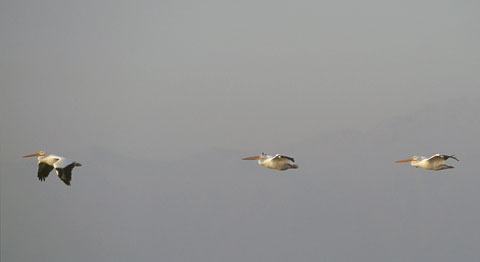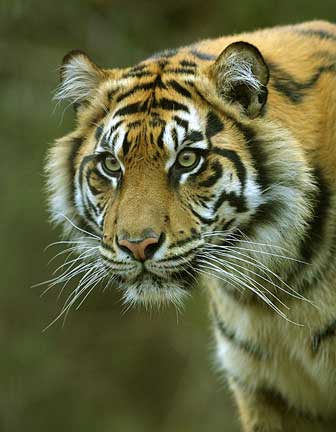Introduction
There are some lenses that have almost universal appeal for photographers. Fast ultra-long telephotos are among these, and few lenses are as appealing as a 300mm f/2.8. At the top of the heap of this rarified grouping are the new (1999) Image Stabilized (IS) ultra-telephotos from Canon — the 300mm f/2.8, 400mm f/2.8, 500mm f/4 and 600mm f/4 IS lenses, part of Canon’s top-of-the-line "L" series. In January 2000 I purchased the 300mm f/2.8L IS. This was to enable me to pursue a broader interest in nature and wildlife work in addition to my landscape photography.
A few days after purchasing the lens I left for a winter vacation in Southern California. I brought the 300mm along because part of my itinerary was to do some shooting at theSalton Sea. I couldn’t be more pleased with the results.
About The Lens
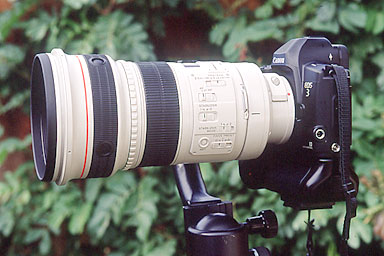
When one has just spent U.S. $5,000 on a lens it’s hard to be objective. Let me try though. It’s beautifully made, in the current Canon idiom. Everything about its design and construction reeks quality. In fact this lens is probably as fine an optic as Canon knows how to make, and that’s saying a lot. Reportedly Canon spent $11 million developing this line of 4 lenses, and it shows in every respect.
Independent tests, including one by France’sChasseur d’Imagesmagazine rank this as among the finest 300mm’s ever made. According to their tests, image quality is almost completely uniform from edges to center, and from f/2.8 through f/8. This is remarkable. My own more pragmatic tests show that this lens is usable wide-open without any hesitation. Stopping down only increases resolution and micro contrast very slightly. When you pay for f/2.8 with this lens, you get an f/2.8 that is every bit as usable as any other aperture. That’s what one is paying for.
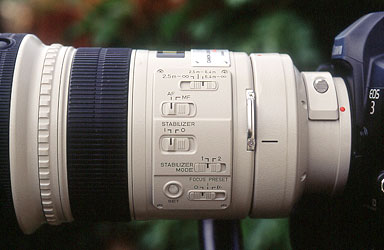
This, it shouldn’t be forgotten, is an Image Stabilized lens. This means that it has circuitry capable of reducing image shake by 2-3 full stops. Hand-holding at 1/125 sec should be quite possible. I have hand-held my Canon 100~400mm IS lens at 1/125 second withexcellent results. But, this lens is bulky and heavy, weighing in at 2.7Kg. It can, of course, be hand-held, but I wouldn’t want to for long.
One advancement that Canon has included in this latest generation of IS lenses is the ability for IS to work even when the lens is tripod mounted. This is very worthwhile since even a tripod mounted lens is subject to vibration. I felt tremendous confidence using this lens under a wide range of conditions.
Because the front lens element is so large filters are mounted internally. Canon makes available (finally) an internal polarizer, and gel filters can be used internally as well. Of course the lens can be manually focused at any time and also features a preset button. This allows you to pre-focus the lens on a particular spot and then return to that exact point of focus by the turn of a conveniently located ring. There are manual focus override buttons located around the front of the lens. Very thoughtfully designed. Clearly Canon’s designers have listened to feedback from photographers when designing this lens.
Another nice design touch is that the rotating tripod mount collar is removable. For times when the lens is going to be hand-held this lowers the weight and also makes it more comfortable to hold.
The only real complaint that I can make is that the lens comes with a hard plastic case with the words,Canon 300mm Lensboldly on the front. Who would use this? It screams "steal me". I found that the lens does fit in myLowiPro Omni Treckerbag, along with my 6 other lenses and 2 bodies, but it makes the weight excessive. I found a small soft shoulder bag that fits it very nicely and is convenient for field use.
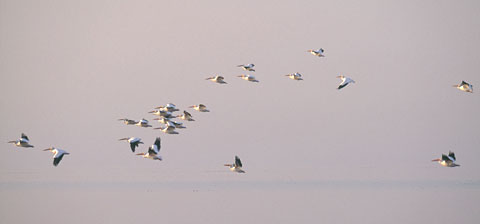 Pelicans in Flight, Salton Sea, 2000
Pelicans in Flight, Salton Sea, 2000
This photograph was taken with the 300mm lens . The shot was taken wide open at 1/500th sec at f/2.8 on Fuji Provia 100F. It was taken shortly after sunrise and the flight of pelicans was flying into the rising sun, which cast a warm glow across theSalton Sea. The EOS3 was mounted on aWimberley Sidekickgimbal mount atop an Arca Swiss B1 head and Gitzo 1349 carbon-fiber tripod.
This photograph was taken with the 300mm lens and Canon’s 1.4X Extender for an affective focal length of 420mm at f/4. It appears every bit as sharp as the lens does alone, even though it’s being used wide-open. Remarkable performance!
Click on both of these pictures for a larger view. The sharpness and clarity is exceptional. On an 18" wide print you can see the feathers on the pelicans!
A Lesson Learned
One thing that I was not prepared for was how shallow depth of field is with such a long lens and such a fast aperture‚ particularly when used with the 1.4X extender. A number of otherwise worthwhile frames were rendered unacceptable because foreground birds were out of focus‚ even when hundreds of yards away.
If you have a Canon EOS3 (or later) body and one of the new generation Canon IS ultra-telephoto lenses you may be interested in having Custom Function #19 added by a Canon Service Center.
What About the 2X Extender?
The 300mm as well as the 400mm, 500mm and 600mm IS lenses are designed specifically for use with Canon’s 1.4X and 2X extenders. The quality with the 1.4X is truly excellent‚ almost as good as the lens by itself. But, what about with the 2X extender?
Below is a full frame taken with the 300mm lens and the 2X, for an effective focal length of 600mm at f/5.6. The shot was taken wide-open, tripod mounted, on Fuji Provia 100F.
The frame below it is a "actual pixels" enlargement of the bird. This means that this is the maximum resolution possible from this 3200 DPI scan. You can see the grain of the film so we’re at the resolution limits of the film/lens system. In such an extreme enlargement there is some softness. This would likely have been improved somewhat if I had stopped down one or two stops.
All-in-all I judge the use of this lens with the Canon 2X quite acceptable for just about any use, but would suggest stopping down as much as possible for maximum resolution.
 Salton Sea, January 2000
Salton Sea, January 2000
![]() Salton Sea‚ Actual Pixels, January 2000
Salton Sea‚ Actual Pixels, January 2000
Long and heavy lenses like the Canon 300mm f/2.8 can be awkward to use in the field when shooting wildlife. TheWimberley Sidekicksolves all of the problems of tripod mounting such a lens and is a must-have for field use.
All photographs above were scanned with anImacon FlexTight Photoscanner at 3,200 DPI. Normal "sharpening" in PhotoShop was applied.
Photographed with Canon D30 at ISO 400. 1/125th sec @ f/2.8 with a Canon 300mm f/2.8L IS . RAW Mode.
The300mm f/2.8was used along with theCanon EOS-D30digital SLR for some fascinating photographs at theToronto Zooand in a further photo essay calledCaptive Wildlife. These both show the lens to good advantage .
